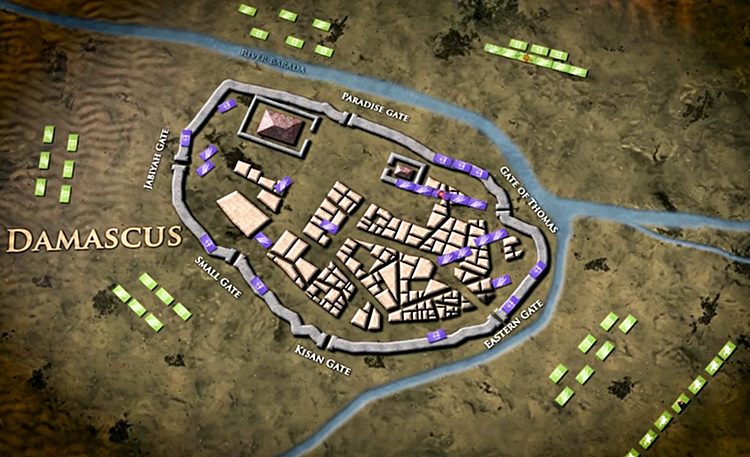
Capture of Damascus |
year: 63418 Sep 634 |
| The Arabs captured the city of Damascus | ★ ★ ★ ★ ★ |
|
enemy: Arabs
|
location: Damascus, Syria
|
accuracy:
●●●●●
|
|
battle type: City Capture |
war: Arab Conquest of Syria |
modern country:
Syria |
| ▼ The Byzantines(emperor: Heraclius) | ▼ The Enemies | |
| Commander: | Thomas (Heraclius’ son-in-law) | Khalid ibn al-Walid |
| Forces: | 16,000 | 20,000 |
| Losses: | heavy | low |
| Background story: |
| After their uninterrupted series of successes in Syria, the Muslims marched north to Damascus. Having isolated Damascus, Khalid ibn al-Walid surrounded the city on August 21, 634. The Byzantine governor was Thomas, the son-in-law of Heraclius. Emperor Heraclius was at Antioch and dispatched a relief force of 12,000 men. Khalid sent against them Rafay bin Umayr with 5,000 troops. They met 20 miles north of Damascus at Uqab Pass (Eagle Pass). This force was soon surrounded by the Byzantine troops but Khalid arrived in time with another column of 4,000 men and routed the Byzantines. It has since come to be known as Battle of the pass of Uqab. In the meantime, in Damascus, the Byzantines attempted two sorties but failed and retreated back, inside the walls. |
The Battle: |
 Muslim practice was known: if a city surrendered, the inhabitants would be spared, but if a city resisted, they would be killed. After the surrender of the city, the Muslims disputed the terms of the peace agreement. They finally agreed that the peace terms given by Abu Ubaidah would be met. The Byzantine army was given a deadline of 3 days to go as far as they can, with their families and belongings.  Siege of DAmascus |
Noteworthy: |
| Khalid was furious because he thought that was played by the Greeks. After the 3 days deadline was over, the Muslim cavalry attacked the Roman army by catching up to them using an unknown shortcut (Battle of the Brocade). |
Aftermath: |
| One of the most important Byzantine cities was lost. Later, Damascus became the capital of the Umayyad Caliphate, prospered and became one of the most dazzling cities of the world,. Until 750 AD. |
|
|
